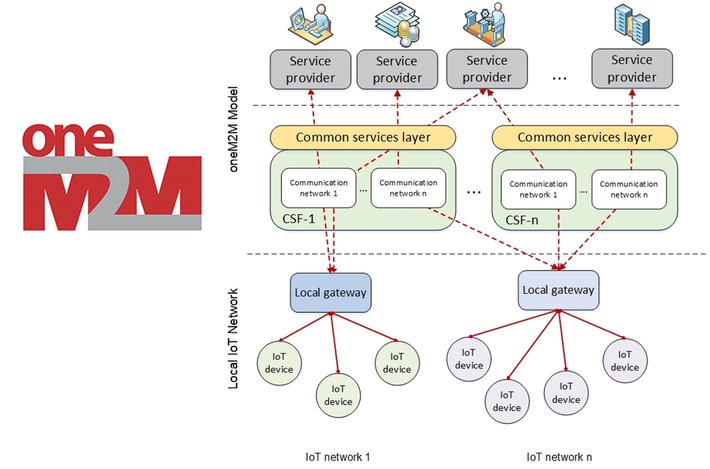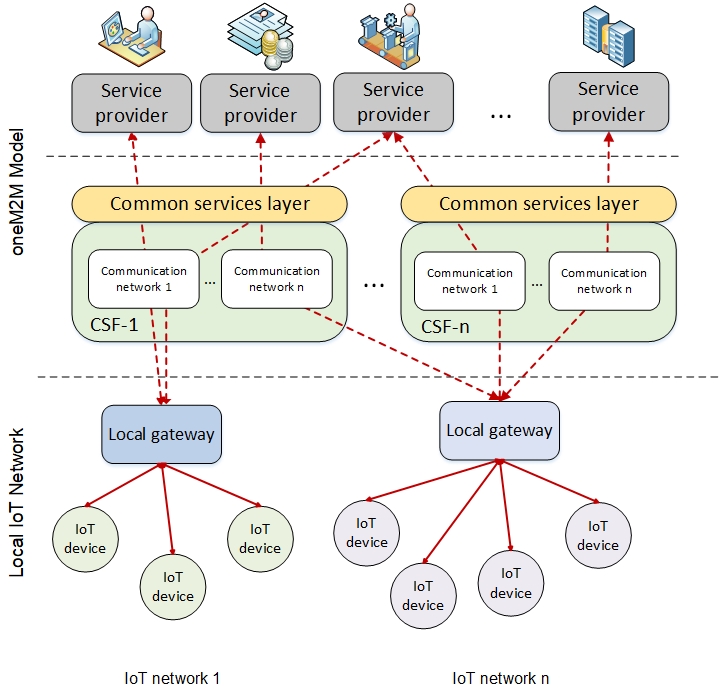
Internet of Things Platforms Interoperability
Due to IoT ecosystem's complexity, no single technology can deliver a complete IoT solution on its own. From connectivity, sensors, and gateways to the cloud and application systems, an IoT architecture is composed of various components working in concert with each other. As a global partnership project, oneM2M develops standard specifications that cover requirements, architecture, security solutions, and interoperability for machine-to-machine (M2M) and IoT technologies. oneM2M is a service layer platform to support end-to-end IoT services including M2M communications by developing technical specifications. In this blog, we introduce oneM2M and its service layer functions.
1 IoT Interoperability
In general view, an Internet of things (IoT) system connects things and make them easily accessible. Nowadays, IoT goes beyond the typical computer-basedInternet model to a distributed heterogeneous model of connected things. Due to the advantages of processing technologies and the advent of new communication solutions, IoT systems are more complex that have the capabilities of sensing information about the environment, capabilities of collecting physiological measurements, and machine operational data, abilities of identifying users, animals, other things, and events in an environment, and the capabilities of processing and communicating these data with other things [1]. Basically, with such a diverse, complex and heterogeneous model of the IoT, interoperability and integration between different platforms arise numerous challenges.
The interoperability is defined by IEEE as “the ability of two or more systems or components to exchange information and to use the information that has been exchanged” [2]. Different categories of interoperability have been emerging, such as technical interoperability, semantic interoperability, syntactic interoperability, and cross-domain interoperability. All these types of interoperability are needed to support seamless and heterogeneous communications in the IoT [1]. Achieving interoperability is vital for interconnecting different IoT platforms within different communication networks.
oneM2M is a service layer platform to support end-to-end IoT services including machine-to-machine (M2M) communications by developing technical specifications. As shown in Fig. 1, oneM2M provides the interoperability capability with IoT platforms, in which different IoT applications and devices are able to interconnect with each other [3]. oneM2M’s architecture and standards for M2M communications are designed to be applied in many different industries, such as eHealth and Telemedicine, industrial automation, and home automation.

Fig. 1. IoT interoperability in oneM2M layered model.
1.1 oneM2M Service Layer Platform
Basically, oneM2M is a global partnership project developing standard specifications that covers requirements, architecture, security solutions and interoperability for M2M and IoT technologies. oneM2M enables different IoT services to be supported by the same platform [4]. Interoperability in which different applications can use the same management function for data, communication, device, and security, is the key part of oneM2M standard. The oneM2M architecture comprises three layers: application layer, common services layer, and network services layer. A common services entity (CSE) in oneM2M represents a set of common service functions (CSFs) to other entities. Data and device management, discovery, location, charging and billing, and security services are some examples of these services [5]. Fig. 2 depicts a group of CSFs offered by oneM2M service layer and some of them, which are related to our platform of IoT billing and charging, are introduced as follows.
Service Charging and Accounting To support different charging models (e.g., online real-time credit control) in the service layer, service charging and accounting (SCA) CSF provides different charging functions. Based on the charging model (e.g., subscription-based or event-based) SCA-CSF sends the charging information transformed from the specific recorded information to the billing domain. To this end, SCA-CSF provides the logical functions of charging management, charging triggering, and offline charging. The charging management function handles charging related policies, configurations, and interacting with the charging system in the underlying network. The charging triggering function captures the chargeable event and generates recorded information for charging. To handle the offline operations, the offline charging function generates service charging records based on the recorded information [5].

Fig. 2. Common services functions (CSFs) in oneM2M layered model.
Registration To benefit M2M services, any entity in the application layer or common services layer needs to register with a registrar CSE and its information is delivered to the related CSE. The registrar is responsible for verifying the request, and checking the authentication and authorization of the requester. Basically, the registration information of an IoT node consists of its identification and reachability schedules. The reachability schedules specify when messaging can occur between nodes.
Data Management and Repository To enable AEs to exchange data with each other, the data management and repository (DMR) CSF provides data storage and mediation functions. It includes the capability of collecting data for the purpose of aggregating large amounts of data (e.g., application data, device information, and access permission), converting to a specified format, and storing it for analytics and semantic processing.
Device Management To enable AEs to manage the device capabilities on the network with no need to understand the technology-specific protocols or data models, the device management (DMG) CSF provides management of device capabilities. In this case, the required information is available to AEs for administrative purposes (e.g., diagnostics and troubleshooting). DMG has some functional components and interfaces to perform the features of device management, translation and adaptation functions. When a request is received, DMG translates it with the associated identifiers that can be understood by the management server.
Security Fundamentally, the security (SEC) function of CSF used to provide the functionalities of access control, sensitive data handling, identity management, and security management. To protect the local credentials, which are required for secure storage and manipulation, SEC-CSF performs some functions to support several cryptographically separated security environments [5]. By authorizing and establishing a security association between corresponding M2M/IoT Nodes, SEC-CSF provides the services of access control, confidentiality, and integrity.
References
1. M. Elkhodr, S. Shahrestani, and H. Cheung. The internet of things: new interoperability, management and security challenges. arXiv preprint arXiv:1604.04824, 2016.
2. Anne Geraci, Freny Katki, Louise McMonegal, Bennett Meyer, John Lane, Paul Wilson, Jane Radatz, Mary Yee, Hugh Porteous, and Fredrick Springsteel. IEEE standard computer dictionary: Compilation of IEEE standard computer glossaries. IEEE Press, 1991.
3. C. Wu, F.J. Lin, C. Wang, and N. Chang. OneM2M-based IoT protocol integration. In 2017 IEEE Conference on Standards for Communications and Networking (CSCN), pages 252–257. IEEE, 2017.
4. oneM2M. SMART CITIES DONE SMARTER. http://www.onem2m.org/images/files/oneM2M WhitePaper SmartCitiesDoneSmarter.pdf, February 2017.
5. ETSI. oneM2M; Functional Architecture. TECHNICAL SPECIFICATION 2.10.0, European Telecommunications Standards Institute, 2016.